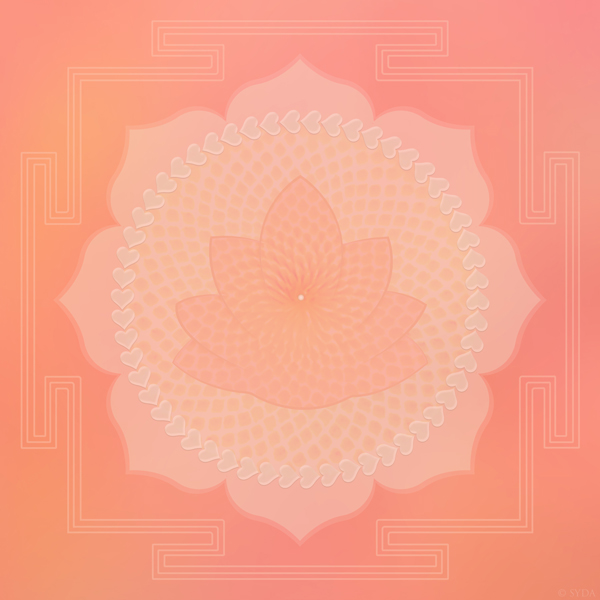Siddha Yoga Yantra for Birthday Bliss:
A Gift from Gurumayi Chidvilasananda

About the Siddha Yoga Yantra for Birthday Bliss
by Ami Bansal
A yantra is a sacred diagram, an image that serves as a focus to still the mind. This yantra was created by Gurumayi Chidvilasananda. It is Gurumayi’s gift to all who visit the Siddha Yoga path website during the celebration of her birthday month of June, known as Birthday Bliss.… Read more
Yantra
In ancient times in India, the vibrant forms of yantras were seen by yogis in deep meditation. A yantra depicts the blissful, freewill evolution of supreme Consciousness as it creates the myriad colors, sounds, and forms that make up the universe. The yantra also depicts the involution of Consciousness as it returns to its pristine source. Additionally, a yantra embodies the shakti of a particular deity or aspect of the supreme Self.
The Sanskrit word yantra literally means “instrument.” Yam means “to hold, sustain, or support,” and tra means “to protect.” Therefore, a yantra is an instrument that holds the divine energy of the deity and protects the one who meditates on it. A yantra leads a seeker’s awareness from the mind into the Heart, from the form to the formless.
Elements of the Yantra
Bhupura
Yantras are traditionally enclosed in a bhupura—a square with four gates. Bhupura literally means “home” or “region of the Earth.” The bhupura provides a boundary and acts as a container for the power of the yantra. It signifies both the physical world and the human body, within which the spiritual world is revealed.
Lotus
The lotus is a universal symbol of purity and spiritual unfoldment. One of the Sanskrit words for lotus is kamala. According to a traditional analysis of kamala, the letter ka means “splendor” or “brilliance,” and mal means, “to hold or possess.” In a yantra, a lotus signifies an energy center that constantly vibrates with light and the divine sounds of mantras. When a seeker meditates on a yantra, the lotus unfolds, leading their awareness into the Heart.
The Siddha Yoga yantra for Birthday Bliss contains two lotuses—a seven-petaled lotus and an eight-petaled lotus.
Seven-Petaled Lotus
In the center of the Siddha Yoga yantra for Birthday Bliss is a lotus with seven petals. This lotus is in the form of Lord Ganesha, the deity of this yantra. Lord Ganesha is the aspect of the Absolute that represents new beginnings and removes all obstacles. The form of Lord Ganesha suggests the shape of the Sanskrit symbol for the primordial sound AUM— . Thus, he is said to embody the primordial sound. The seven petals of this lotus symbolize the seven notes of the Indian musical scale, which arise from AUM.
. Thus, he is said to embody the primordial sound. The seven petals of this lotus symbolize the seven notes of the Indian musical scale, which arise from AUM.
In some Shaiva scriptures, the number seven signifies Shri Guru, the grace-bestowing power of God. The scriptures say there are six forms of Lord Shiva, and beyond all these is Shri Guru—the seventh Shiva, Parama-shiva, the supreme Absolute who takes an embodied form. On the Siddha Yoga path, the bestowal of Shri Guru’s grace through shaktipat initiation marks the beginning of an aspirant’s spiritual journey to liberation.
Eight-Petaled Lotus
The number eight is sacred to the Goddess, the all-pervading Shakti, the energy that is the life force within every being.
According to the scriptures, one of the energy centers in the subtle body is the hrit chakra or hridaya chakra, the eight-petaled heart-lotus. The heart-lotus is located in the region of the physical heart, and it is the seat of the luminous atman—the soul. This pristine heart-lotus pulsates with unconditional love.
Circle of 54 Hearts
In a yantra the circle represents the spiraling evolution and involution of Shakti’s creative power.
In yogic philosophy the number 54 is significant because it is half of the highly auspicious number 108. Additionally, the letters of the Sanskrit alphabet are composed of 54 sound vibrations. Japa malas are traditionally made with 108 beads or divisions of this sacred number—54, 36, 27, or 9.
Sahasrara
The delicate petals within the circle of hearts represent the sahasrara, the highest center in the subtle body and the zenith of the spiritual journey. Sahasrara literally means “thousands of rays of light” and has been described in the Indian scriptures as a lotus of a thousand petals, symbolizing the infinite effulgence of supreme Consciousness.
Nila Bindu
Nila in Sanskrit means “blue,” and bindu literally is “a dot” or “a focal point.” Due to the unsurpassable brilliance of the nila bindu, Baba Muktananda describes it as the Blue Pearl. This is the home of the inner Self and source of the life force within our being.
In his autobiography, Play of Consciousness, Baba Muktananda describes a vision he had of the Blue Pearl in meditation. Baba writes:
I saw a celestial radiance like a mist, and in the midst of this radiance, the Blue Pearl. This brightness increased day by day. It is always found around the Blue Pearl, and it is said that the radiance of the firmament within the sahasrara comes from the splendor of the Blue Pearl. I meditated on it every day, and each day there arose the awareness “I am the Self.”1
Invitation
This Siddha Yoga yantra is a meditation tool. You are invited to set aside time each day during Birthday Bliss to visit the Siddha Yoga path website and meditate on this sacred image—Gurumayi’s gift to you.
1 Swami Muktananda, Play of Consciousness: A Spiritual Autobiography (South Fallsburg, NY: SYDA Foundation, 2000), p. 198.


